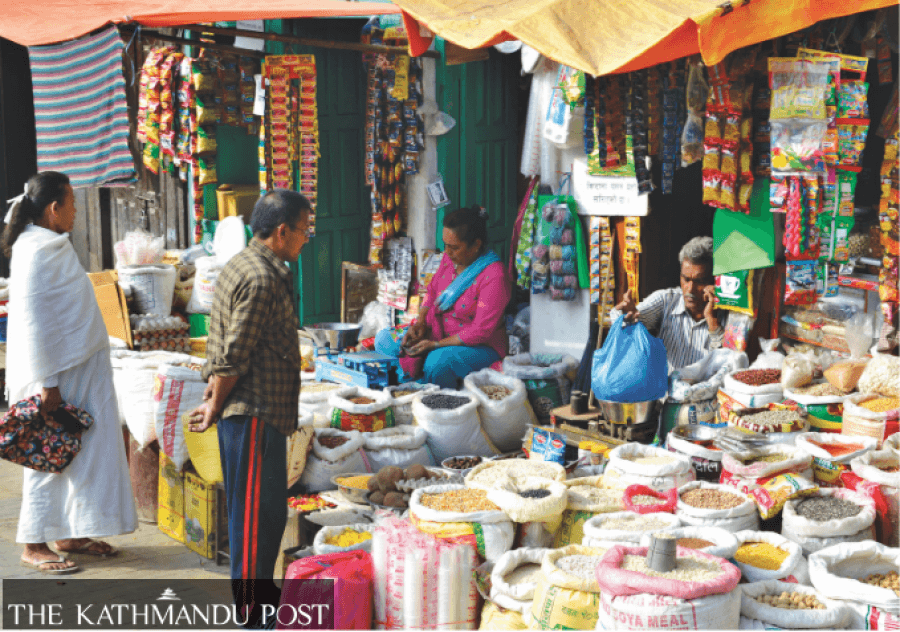
The average annual inflation of 6.32 percent is only slightly higher than the government’s projection, but it is a four-year high. Post File Photo
Inflation did not hit double digits in July as projected, but economists warn that massive campaign spending by political parties during the upcoming elections could push up price levels.
Government expenditure during the election will also make money flow into the economy.
Nepal's inflation was recorded at 8.08 percent in July when the fiscal year closed, which is double the last year's figure. The price rise mercifully did not go into double digits, but it is crushing consumers, economists say.
“The official inflation rate, however, doesn't even fully capture how bad the situation is,” said economist Bishwambher Pyakuryal.
Nawal Kishor Sah, who runs a clothing shop at Nayabazaar, Kirtipur, says the official figure is understated. “The cost of living is so high. Prices of rice, lentils, vegetables, fruits, petrol and rent—have gone through the roof,” he told the Post.
“Children's education, health check-up bills and room rent are now beyond many people’s reach in Kathmandu,” said Sah, 31, who lives in a rented flat with his family of eight.
Since the pandemic, Sah has been taking loans to feed his family and his debt has piled up. “The interest rates on the loans are rising too,” said Sah.
According to the Nepal Rastra Bank, the consumer price inflation in July doubled due to a rise in fuel and food prices. Supply chain disruptions caused by the Russia-Ukraine war and a weakened Nepali rupee against the US dollar also sent prices soaring.
The average annual inflation of 6.32 percent is only slightly higher than the government’s projection, but it is a four-year high.
According to the central bank, the annual average consumer price inflation in food and beverage reached 5.69 percent in 2021-22, down from 5 percent in 2020-21.
The price of ghee and oil swelled by 26.13 percent, pulses and legumes became dearer by 9.92 percent, and the price of tobacco and alcoholic drinks rose by 8.57 percent.
Under the non-food and services category, the price of transportation increased by 15.82 percent, education by 8.78 percent, furnishing and household equipment by 7.09 percent and recreation by 6.68 percent.
“The election campaign has started,” said Pyakuryal. “The campaign will increase money flow in the market and increase government expenditure, which will make everything more expensive.”
Nepal has slated two elections—federal and provincial—for November 20.
The Inflation Expectations Survey report published by the Nepal Rastra Bank recently says 94.7 percent of the survey respondents expected price levels to increase by 14 percent in the next three months.
Pyakuryal doubts the government’s official inflation rate below 10 percent.
“None of the consumers feels inflation is in the single digits,” he said.
As low- and middle-income people will be hit the hardest by rising inflation, economists say that more people will be dragged below the poverty line as they have started cutting down on consumption because incomes cannot keep up with market prices.
Government policy too has not supported the people hit hard by the ever-growing market prices.
Despite a reduction in the prices of petroleum products—at least three times in two months—Nepal’s oil monopoly has no immediate plans to cut fuel prices.
Nepal Oil Corporation says its losses and pending dues to the Indian Oil Corporation, its supplier, have piled up, and there is no way fuel prices can be reduced until the debts have been cleared.
The corporation has jacked up the price of petrol 13 times in the past year, from Rs129 to Rs181 per litre. Diesel and kerosene prices have increased from Rs112 to Rs172 per litre.
According to “The War in Ukraine and Its Effects on Maritime Trade Logistics”, a report published by the United Nations Conference on Trade and Development in July, lower middle-income countries may suffer an additional 4.2 percent increase in consumer food prices among the four economies—high income, upper middle income, lower middle income and low income.
Lower middle-income economies, including Nepal, may suffer higher food prices as dry bulk shipping charges have risen sharply, pushing up their food import costs, the report said.
Economist Keshav Acharya says that despite a fall in fuel prices globally, it doesn’t seem to be dropping in Nepal.
“This will definitely increase the cost of production and make domestic products less competitive,” he said. "The government itself is causing inflation to rise," said Pyakuryal.
The festival season has begun, but consumer confidence is low.
“As the government has failed miserably to tame inflation, it will be reflected on economic growth as people will hold back on spending,” said Pyakuryal.
The government should open fair price shops by coordinating with the private sector, economists say.
Experts believe that the ongoing drought in many districts and the government's failed promises to ensure chemical fertiliser for farmers will make things complicated in the next few months.
Farmers expect their harvests to fall significantly as they were unable to get chemical fertiliser. Prices of foods are expected to rise
Steep inflation has led to shrinkflation, which economists say is a business strategy of downsizing the package to reduce the quantity to avoid having to raise prices. Manufacturers give less for the same price—which people hardly notice—to keep the business running.
The World Food Programme says that as a result of rising food prices over the period, the cost of the food basket—rice, wheat flour and some fruits—continued to increase, while prices of pulses, soybean oil and some vegetables declined in July.
Still, the cost of the food basket was 11 percent higher in July 2022 compared to April 2022.
“Inflation is rising and rising, but the government seems to be least bothered to control it,” said Sah. “The rising costs may ruin our upcoming festival plans.”












